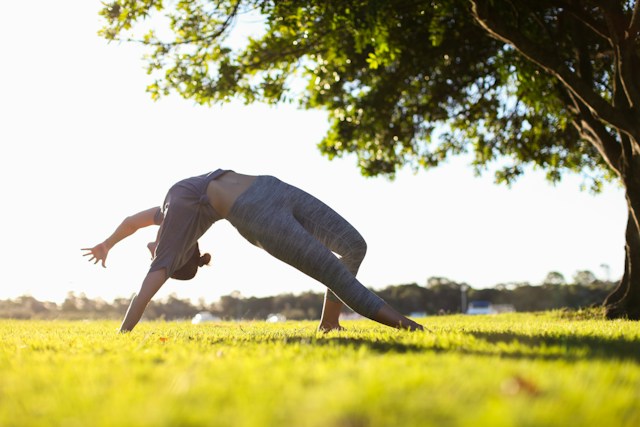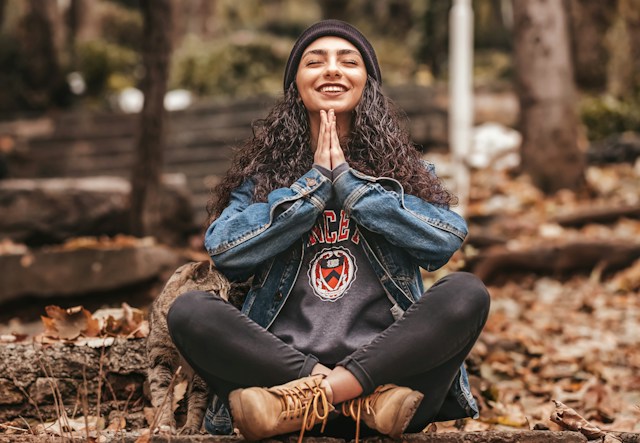Wellness • 02/11/2023
Mindfulness Yoga: 6 Tips for Elevating Your Routine

Revivalist is a reader-supported endeavor and our posts may contain affiliate links. When you buy through links on our site, we may earn an affiliate commission.
Perhaps you’ve practiced mindfulness yoga for a while, but your mat time has started to feel like going through the motions. You might even be a bit bored with your routine and thinking of letting it go amid life’s other responsibilities.
Please reconsider. A quality yoga routine is one of the best preventative medicines, and it’s free. It supports you both physically and mentally.
Guess what? You cannot be bored if you are genuinely present in your practice. That’s why you should practice mindfulness yoga. Here are six tips for elevating your experience.
1. Change Your Scenery

Do you weary of staring at the same four studio walls every time you practice? Have you memorized the motivational poster sayings and find them less inspirational than you once did? Perhaps a change of scenery could revitalize your practice.
Why not try practicing outdoors for a change if the weather permits? Some studios implemented such classes in light of the COVID-19 pandemic to cater to those who might feel uncomfortable breathing deeply with others indoors. You could end up inhaling health benefits. Researchers who studied forest bathers in Japan discovered an increased number of natural killer cells, vital immunity defenders against germs.
Are you feeling adventurous and up for a balance challenge? Why not try yoga on a paddleboard? You’ll get a mini-lesson on how to paddle that will come in handy on your next canoe trip. More importantly, you’ll be forced to perform mindful movement to keep from getting wet. Of course, a dunking or two is all part of the fun.
2. Try a New Style
Is it summer in your neck of the woods? If it is, and you live somewhere like Arizona or Florida, you might not have to pay to recreate the conditions of a hot yoga class. Studios that offer this option heat their studios to 105° Fahrenheit with a humidity of at least 40%. However, you might be able to experience these conditions in the great outdoors. If not — why not try such a studio? It’s the closest you can come to an authentic practice on the Indian subcontinent without a passport.
Hot yoga isn’t your only option. There are scores of yoga styles to explore. Is your regular vinyasa practice no longer providing enough of a challenge? Why not try Ashtanga? This challenging sequence evolves through six levels, although most yogis never progress past the intermediate series. You’ll accomplish some impressive gymnastics-like feats if you dedicate yourself.
Perhaps you want something a little more low-key. If so, why not give Yin a try. This style may represent the ultimate in mindfulness yoga as you hold positions for three to five minutes. Your objective is to find stillness, both inner and outer — testing the theory that you are never bored if you are fully present.
3. Use Different Breathing Techniques
Your breath is a link to mindfulness. Pranayama is the most vital part of any yoga practice, but there’s no rule that says you must stick with ujjayi all class, every class. There are dozens of ways to connect with your breath, and focusing on them keeps you grounded in the present moment.
For example, you can practice boxed breathing like the Navy SEALS. In this style, you inhale for a 4-count, pause for four, then exhale for the same length.
However, holding your breath during standing asanas or vinyasa work could make you dizzy and lightheaded — which is why so many teachers recommend ujjayi during flows. However, you can also practice even breathing, inhaling for five, then exhaling for five, making each inhale and exhale as smooth as possible. Doing so could help you manage more challenging poses than you typically master by coaxing your muscles to relax and stretch just a bit further.
4. Start and End Your Day
Yoga is an ideal practice for any time of day. However, you can take advantage of your body’s natural sleep-wake cycles to enhance your practice.
For example, why not start your day with a few moments of gentle yoga? You might begin with a meditation, then move on to some gentle stretches in bed before moving to the floor. It’s the perfect way to marry mindfulness and yoga while taking advantage of the hypnopompic period — when your brain is in a suggestible, dreamlike state — to set an intention and mood for your day.
Yoga is also the perfect way to unwind at day’s end. It’s not the best for practicing vigorous styles like Ashtanga or Vinyasa, but a gentle yin or restorative session can ease you into dreamland. Include plenty of deep breathing to further relax your muscles and get ready for sleep.
5. Bring a Furry Friend

Have you heard of goat yoga? It is what it sounds like. Try maintaining a tree pose while Billy butts against your leg — now there’s a balance challenge!
Some studios and area Humane Societies have married the therapeutic effects of animals with yoga. You can find yoga with cats, puppies, goats — there’s probably a class for boa constrictor enthusiasts out there somewhere. Of course, you can invite your furry friend to practice with you in your living room.
6. Study the Philosophy
If you want to take your mindfulness yoga classes to the pinnacle, you need to go back to the beginning. Remember, yoga didn’t begin as a form of physical exercise. It originates in seated meditations performed by Eastern mystics from various faiths. You can see the influences of Hinduism and Buddhism most prominently today, although it also draws from Taoist and Jainist philosophies.
Fortunately, you can immerse yourself without spending a dime on an overseas retreat, thanks to the wonders of technology. For example, you can find fabulous channels on YouTube, such as Plum Village, where you can listen to audio lectures by spiritual leaders like Thich Nhat Hanh.
You’ll find subreddits and web pages galore dedicated to various spiritual practices. You may find your calling — but you may also find great comfort even if you don’t convert. Many leaders, such as the Dalai Lama, see no inherent contradiction between practices like Buddhism and Christianity.
Mindfulness Yoga
Has your yoga practice grown a bit stale? If so, you might want to introduce more mindfulness to your routine.
Follow the six tips above for elevating your practice to mindfulness yoga and find greater peace on the mat. You’ll deepen your connection with yourself and your divinity while renewing your commitment to mental and physical health.
Subscribe to Our Weekly Newsletter
We would love to connect deeper with you!


